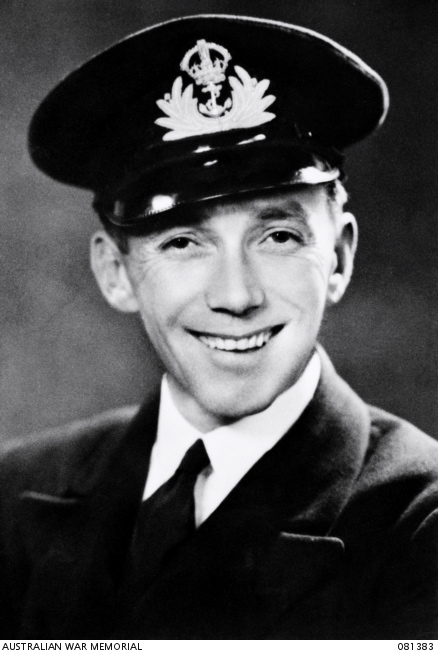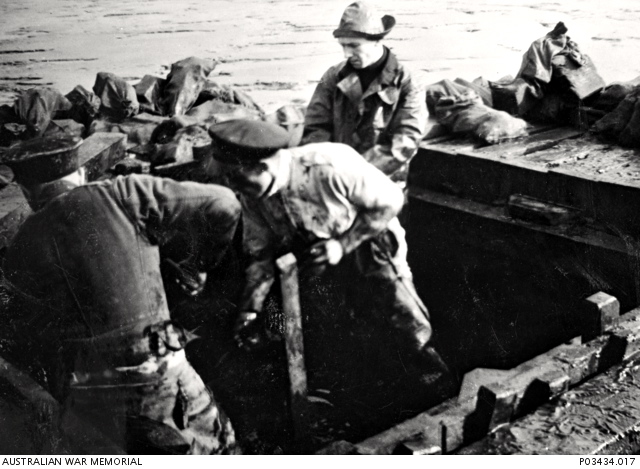Son of Alfred and Eva Jane (nee Riggs) Goldsworthy. He was Australia's most highly decorated Naval Officer. He was educated at Kapunda High School, South Australia and later went to the Adelaide School of Mines before attending Adelaide University, where he worked as a technician in the Physics Department. In the years before the war, he was engaged in the electrical sign business in Western Australia. He married Maud E. Rutherford on 4 November 1939. After the outbreak of war he applied to join the Royal Australia Navy but was initially rejected by the Navy because of his small stature being only 5 feet 5 inches tall and of slight stature. He made a second attempt to enlist and was accepted as a probationary Sub-Lieutenant in the Royal Australian Naval Volunteer Reserve on 24 March 1941. Shortly afterwards he was sent to England to complete his officer training. On arrival in England he volunteered for the Rendering Mines Safe Section of HMS Vernon. He quickly proved himself a skilled officer who was able to use his pre-war training in electricity and physics to good effect. His work often required him to defuse mines underwater wearing a bulky diving suit that made the slow, steady movements required in this work very difficult. On 13 August 1943 he defused a German mine in the waters off Sheerness using a special diving suit which he and a colleague had helped to develop. In September and October 1943 he defused two mines, one of which had rested at a Southampton wharf for two years and the other in the River Thames. For these actions Goldsworthy was awarded the George Medal (Gazetted in April 1944). In April 1944, he disarmed an acoustic mine that had lain in the water off Milford Haven for two and a half years. In September 1944 he received the George Cross for his work in recovering and defusing mines between June 1943 and September 1944. He was also Mentioned in Dispatches in August 1944 ‘For courage and undaunted devotion to duty'. Before the Allied invasion of France he was involved in the selection and training of men for port clearance and he was awarded the Distinguished Service Cross in January 1945 for his bravery and leadership in clearing Cherbourg Harbour, which was needed urgently to supply Allied troops advancing across France. On one occasion he disarmed a new German 'K' type mine in 15 metres of water under enemy shellfire. After his work in France, he served with the United States Navy in the South West Pacific Theatre, helping to defuse Japanese mines in the Philippines and in the Borneo area. He was among the first to enter and search the caves on the island of Correigidor for mines and booby traps. By the time the war ended, he had been promoted to Acting Lieutenant Commander and was Australia's most highly decorated naval officer, having rendered safe more than 300 mines safe. He was demobilised from the navy on 24 May 1946 and returned to Perth and worked as the production manager of a neon light company until retiring in 1974. He was re-commissioned into the RANVR in 1953 in order to take part in the Coronation celebrations for Queen Elizabeth II and embarked in the aircraft carrier HMAS Sydney which conveyed the coronation contingent to the UK. After his wife's death, in 1959, he married Georgette Johnston in 1968. In 1991 he became Vice-chairman (overseas) of the Victoria Cross and George Cross Association and was also the patron of the Perth Underwater Explorers Club. The Leon Goldsworthy Ward at Hollywood Private Hospital in Perth was named in his honour.
Son of Alfred and Eva Jane (nee Riggs) Goldsworthy. He was Australia's most highly decorated Naval Officer. He was educated at Kapunda High School, South Australia and later went to the Adelaide School of Mines before attending Adelaide University, where he worked as a technician in the Physics Department. In the years before the war, he was engaged in the electrical sign business in Western Australia. He married Maud E. Rutherford on 4 November 1939. After the outbreak of war he applied to join the Royal Australia Navy but was initially rejected by the Navy because of his small stature being only 5 feet 5 inches tall and of slight stature. He made a second attempt to enlist and was accepted as a probationary Sub-Lieutenant in the Royal Australian Naval Volunteer Reserve on 24 March 1941. Shortly afterwards he was sent to England to complete his officer training. On arrival in England he volunteered for the Rendering Mines Safe Section of HMS Vernon. He quickly proved himself a skilled officer who was able to use his pre-war training in electricity and physics to good effect. His work often required him to defuse mines underwater wearing a bulky diving suit that made the slow, steady movements required in this work very difficult. On 13 August 1943 he defused a German mine in the waters off Sheerness using a special diving suit which he and a colleague had helped to develop. In September and October 1943 he defused two mines, one of which had rested at a Southampton wharf for two years and the other in the River Thames. For these actions Goldsworthy was awarded the George Medal (Gazetted in April 1944). In April 1944, he disarmed an acoustic mine that had lain in the water off Milford Haven for two and a half years. In September 1944 he received the George Cross for his work in recovering and defusing mines between June 1943 and September 1944. He was also Mentioned in Dispatches in August 1944 ‘For courage and undaunted devotion to duty'. Before the Allied invasion of France he was involved in the selection and training of men for port clearance and he was awarded the Distinguished Service Cross in January 1945 for his bravery and leadership in clearing Cherbourg Harbour, which was needed urgently to supply Allied troops advancing across France. On one occasion he disarmed a new German 'K' type mine in 15 metres of water under enemy shellfire. After his work in France, he served with the United States Navy in the South West Pacific Theatre, helping to defuse Japanese mines in the Philippines and in the Borneo area. He was among the first to enter and search the caves on the island of Correigidor for mines and booby traps. By the time the war ended, he had been promoted to Acting Lieutenant Commander and was Australia's most highly decorated naval officer, having rendered safe more than 300 mines safe. He was demobilised from the navy on 24 May 1946 and returned to Perth and worked as the production manager of a neon light company until retiring in 1974. He was re-commissioned into the RANVR in 1953 in order to take part in the Coronation celebrations for Queen Elizabeth II and embarked in the aircraft carrier HMAS Sydney which conveyed the coronation contingent to the UK. After his wife's death, in 1959, he married Georgette Johnston in 1968. In 1991 he became Vice-chairman (overseas) of the Victoria Cross and George Cross Association and was also the patron of the Perth Underwater Explorers Club. The Leon Goldsworthy Ward at Hollywood Private Hospital in Perth was named in his honour.
Family Members
Sponsored by Ancestry
Advertisement
Explore more
Sponsored by Ancestry
Advertisement



